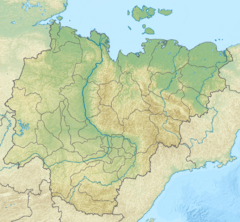| Charky | |
|---|---|
 | |
| Native name | Чаркы (Russian) |
| Location | |
| Federal subject | Yakutia, Russia |
| Physical characteristics | |
| Source | |
| • location | Onelsky Ridge, Chersky Range |
| Mouth | Adycha |
| • coordinates | 66°45′57″N 136°44′54″E / 66.7659°N 136.7483°E / 66.7659; 136.7483 |
| Length | 276 km (171 mi) |
| Basin size | 8,320 km (3,210 sq mi) |
| Basin features | |
| Progression | Adycha→ Yana→ Laptev Sea |
The Charky (Russian: Чаркы; Yakut: Чаркы, Çarkı), also known as Muolakaan (Муолакаан), is a river in the Republic of Sakha in Russia. It is a right hand tributary of the Adycha, of the Yana basin. It is 276 kilometres (171 mi) long, with a drainage basin of 8,320 square kilometres (3,210 sq mi).
Ammonite fossils of the Jurassic have been found in the river basin.
Course
The river begins in the southern slopes of the Onelsky Ridge of the Chersky Range. It heads roughly northwestwards through a valley located between the Chibagalakh Range on the northern side and the Borong Range in the southern. Shortly before joining the Adycha it bends southwards and again northwestwards. Finally it joins the Adycha very close downstream from the mouth of the Nelgese, the largest tributary.
The river usually freezes in early October and stays frozen until late May. Its largest tributary is the Dyalyndya on the left.
The village of Ust-Charky is located on the right bank of the Adycha, a little downstream from its confluence with the Charky.
 |
See also
References
- Russian State Water Register - Река Чаркы (Муолакаан, Чаргы, Молакан)
- Mikhail Semenovich Mesezhnikov, Gerd Ernst Gerold Westermann eds. The Jurassic Ammonite Zones of the Soviet Union, Issue 223
- ^ "Image: Operational_Navigation_Chart_C-6,_3rd_edition.jpg". commons.wikimedia.org. April 1975. Retrieved 2020-01-22.
- Charky - nature.ykt.ru
External links
- Ammonoids of the Genus Yakutosirenites from the Carnian Stage of Northeast Asia
- Ice crust and the neotectonics of northeastern Yakutia
- Meteorological stations and hydrological gauges within the study basins